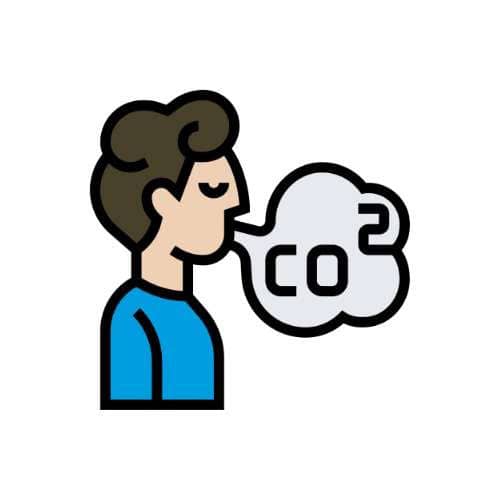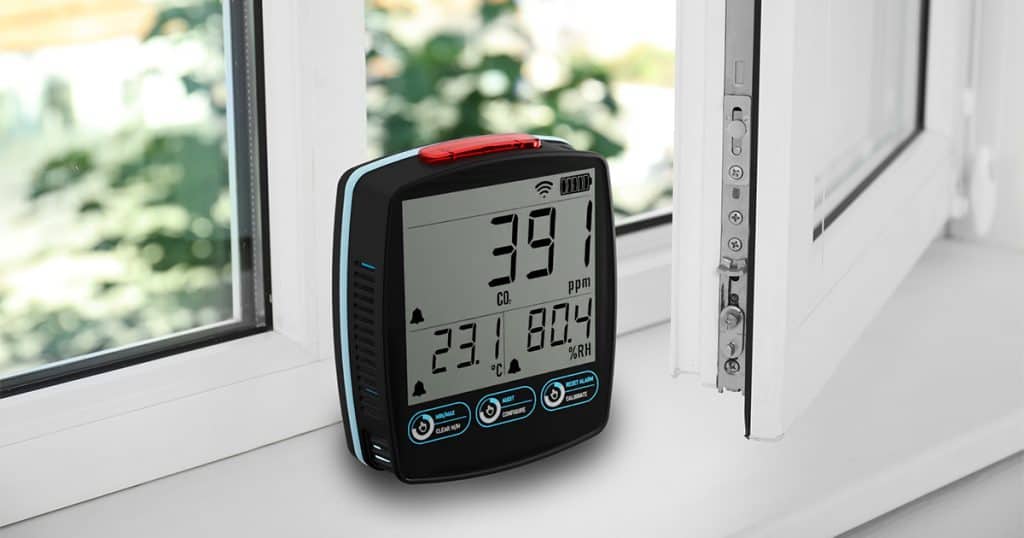Measuring carbon dioxide (CO₂) levels indoors is essential for creating a safe, healthy and productive environment, not just in classrooms, but in offices, healthcare facilities, public spaces and even at home.
If you have ever felt sluggish, developed a headache or found it harder to concentrate, especially in a warm, crowded room, high CO₂ levels could be to blame. Surprisingly, these symptoms often go unnoticed until air quality monitoring highlights the problem.
In this article, we explore why CO₂ monitoring matters, how it works, and what practical steps you can take (Including using Praxas CO₂ meters and data loggers) to ensure cleaner, healthier air wherever you are.
What is Carbon Dioxide (CO₂) ?

Carbon dioxide is a naturally occurring gas, invisible, odourless and tasteless. Indoors, it is mainly produced by people breathing, and by the burning of carbon-based fuels, such as gas heating.
Did you know? Every time we exhale, we release carbon dioxide into the air. Multiply this by dozens of people in a room, and CO₂ concentrations can quickly climb, especially where ventilation is poor.
While outdoors plants, trees and oceans help absorb and process CO₂, indoors we rely on mechanical and natural ventilation to keep levels safe.
Why is CO₂ Monitoring Important?
Small increases in indoor CO₂ can have big impacts on health and wellbeing:
| CO₂ Concentration | Potential Effects |
| 400 to 1000 ppm | Normal indoor air quality |
| 1000 to 2000 ppm | Drowsiness, loss of concentration |
| 2000 to 5000 ppm | Headaches, increased heart rate, nausea |
| Over 5000 ppm | Health risks, requires immediate action |
Poor air quality is linked to:
- Reduced learning and productivity
- Increased absenteeism (sickness)
- Higher risk of airborne infections (COVID-19, flu)
This is why governments are taking action. For example, the Dutch government now mandates CO₂ monitors in every classroom and similar regulations are emerging across the EU and UK.
How Does CO₂ Monitoring Work?
Modern CO₂ monitors and data loggers use advanced sensors to measure air quality continuously.
The Wireless CO₂ and Air Quality Monitors track:
- Carbon dioxide (CO₂) levels
- Temperature
- Humidity
When set thresholds are exceeded, the device automatically triggers an alarm, and can even send alerts via email or text. This means you can act quickly to ventilate the room before health risks escalate.
What Happens When CO₂ Levels Are Too High?
If your CO₂ monitor alarms:
- Ventilate immediately. Open windows, doors or activate mechanical ventilation.
- Cross-ventilate. If possible, create airflow between two openings.
- Relocate activities. If air cannot be improved quickly, move people to another space.
Tip: After ventilating, it is smart to take the monitor outdoors for a few minutes. This helps it recalibrate to fresh air standards.
If levels remain high even after these steps, a building ventilation system inspection may be needed.
What Is a Good CO₂ Level Indoors?
The general guideline is:
- Below 800 ppm = Excellent
- 800 to 1000 ppm = Acceptable
- Above 1000 ppm = Action needed
Schools, offices and healthcare facilities should aim for below 1000 ppm.

Choosing the Right Air Quality Monitor
When selecting a meter or data logger, consider:
- Real-time readings
- Data logging and reporting features
- Alarm notifications (email/SMS)
- Compliance with local regulations
- Self-calibration functionality
The EasyLog Wireless CO₂ Monitor covers all these bases, making it ideal for schools, offices and homes alike.
🔎 Need a reliable CO₂ monitor? Explore the Praxas range of Air Quality Monitors and Data Loggers today because your health starts with the air you breathe.

